
The domestic turtledove is very easy to raise but for it to flourish in captivity it needs a little space. It is thus a bird which one installs in aviary and which does not pose any particular problem. Many people appreciate this pet for its gentleness. Let’s discover who this turtledove is and what its needs are.
Domestic turtledove: main characteristics
The domestic turtledove (Streptopelia roseogrisea domestica) belongs to the family Columbidae. It comes from the Turtle Dove, a wild species of African origin. There are many varieties of turtle doves called breeding among which the famous dove, a vernacular term for a white turtledove and other birds of this large family with white plumage.
The domesticated turtledove has ruby eyes, purple legs, a black beak with purple reflections and a silver rim. Its plumage is of color “turtledove gray” that is to say pink to beige on the whole body except for the underside of the tail, the belly and the throat which are of a graded white. The edge of the wing feathers is lighter and the feathers under the tail of the bird are black and spiked with white. Finally, it can be spotted at its black half ring or half necklace at neck level.
It is larger than many other species of turtle doves, with a weight of 130 g for the female and 210 g for the male, and a length between 24 and 33 cm.
Its life expectancy is about 14 years, but in captivity it can reach 28 to 30 years.
Domestic turtledove : breeding
The male leads an assiduous courtship during the mating season by indulging in a love parade rich in wing beats, kowtowing to the female and cooing. The nest is made roughly by the couple with twigs. After mating, the female usually lays two eggs. These are brooded by the parents who take turns to stick to them for two weeks. After hatching, the lovebirds are fed by their parents with crop milk for about a month, but they begin to leave the nest at the age of two weeks.
Turtle doves can have between seven and nine broods per year.
When the male is absent, other females may participate in the feeding and rearing of the chicks as a sign of solidarity with the mother. This is a phenomenon often seen in captive domestic turtle doves, and these birds are often used to raise chicks of other turtle-dove species.
Raising a domestic turtledove: advice
It is preferable to raise several domestic turtle doves and for their daily well-being, it is better to choose a sufficiently spacious aviary than a cage which is not adapted to this type of birds. A minimum of one cubic meter per individual is recommended.
The aviary can be installed indoors or outdoors. It is simply necessary to make sure that it is sheltered from draughts and if possible from rain, however this bird can withstand the cold perfectly. Note that turtle doves make a lot of dirt. This characteristic encourages many breeders to install them rather outside.
As regards the food of the domestic turtle-dove, it is limited to not shelled seeds of any kind (hemp, wheat, corn, white millet, red millet…). The mixture for turtledove which one finds in garden centers is appropriate to him completely. To supplement its mode and to enable him to fill its needs in vitamins and calcium, it is essential to always leave a cuttlefish bone at its disposal and why not crushed shells, a little greenery, one or two blocks of salt and grit which is not other than a mineral mixture especially worked out for the birds raised in aviary and cage.
One can occasionally give her flour worms and some caterpillars that she will appreciate. Moreover, at the time of the reproduction, it is very important to prepare an egg pâtée for her. It is enough to mix :
A little industrial pâté with seeds,
A hard-boiled egg,
One or two madeleines,
Eggshell.
Drinking troughs must of course be installed so that she can drink as soon as necessary. But she enjoys swimming. A shallow trough is therefore welcome. She does not need toys, unlike some other birds bred in captivity. However, it is useful to put some potted and ground shrubs, twigs and sand and gravel in the aviary because she likes to peck. Don’t forget to hang a nest, either a wicker nest or simply a round container of some kind.
The turtledove is soft and has a good character. It is easy to tame and is considered a pet. It falls under this category in French law. It is moreover a bird on which does not weigh any particular threat.
It is however necessary to regulate the broods because if they follow one another, the mother becomes exhausted and can end up greatly shortening her life expectancy. To do this, the eggs are simply taken and destroyed. Some breeders replace the eggs with scythes, others find it more judicious to breed females and males separately, especially since during the breeding period, the males can be aggressive.






